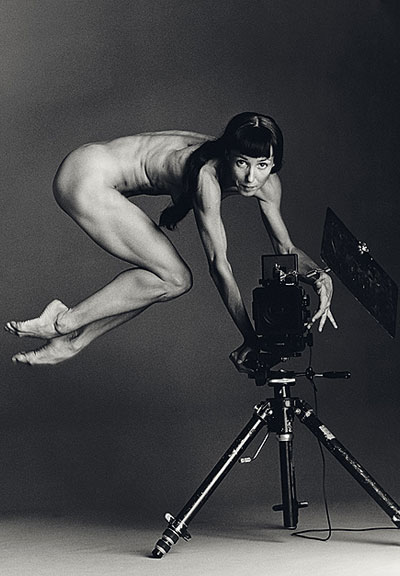
Facsimile Magazine, Published by Haoyan of America. Volume Four, Number Three, 2010. ISSN 1937-2116.
Facsimile March 2010


Facsimile Magazine, Published by Haoyan of America. Volume Four, Number Three, 2010. ISSN 1937-2116.

Picasso es pintor, yo también; [...] Picasso es español, yo también; Picasso es comunista, yo tampoco.
- Salvador Dalí
By Yves Klein, Hotel Chelsea, New York, 1961
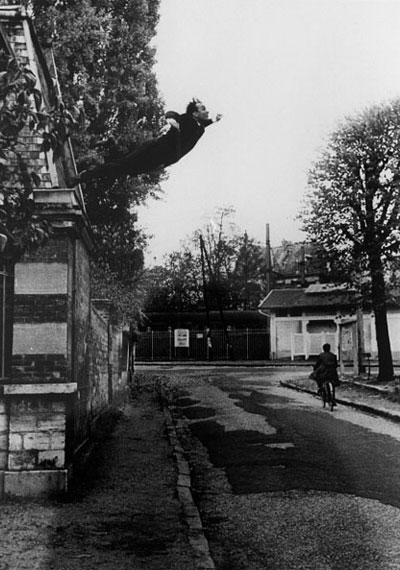
Saut dans le Vide (Leap into the Void), Yves Klein, 1960
Due to the fact that I have painted monochromes for fifteen years,
Due to the fact that I have created pictorial immaterial states,
Due to the fact that I have manipulated the forces of the void,
Due to the fact that I have sculpted with fire and with water and have painted with fire and with water,
Due to the fact that I have painted with living brushes — in other words, the nude body of live models covered with paint: these living brushes were under the constant direction of my commands, such as "a little to the right; over to the left now; to the right again, etc." By maintaining myself at a specific and obligatory distance from the surface to be painted, I am able to resolve the problem of detachment.
Due to the fact that I have invented the architecture and the urbanism of air — of course, this new conception transcends the traditional meaning of the terms "architecture and urbanism" — my goal from the beginning was to reunite with the legend of Paradise Lost. This project was directed toward the habitable surface of the Earth by the climatization of the great geographical expanses through an absolute control over the thermal and atmospheric situation in their relation to our morphological and psychical conditions.
Due to the fact that I have proposed a new conception of music with my "monotone-silence-symphony,"
Due to the fact that I have presented a theater of the void, among countless other adventures...
I would never have believed, fifteen years ago at the time of my earliest efforts, that I would suddenly feel the need to explain myself — to satisfy the desire to know the reason of all that has occurred and the even still more dangerous effect, in other words — the influence my art has had on the young generation of artists throughout the world today.
It dismays me to hear that a certain number of them think that I represent a danger to the future of art — that I am one of those disastrous and noxious results of our time that must be crushed and destroyed before the propagation of my evil completely takes over.
I regret to reveal that this was not my intention; and to happily proclaim to those who evince faith in the multiplicity of new possibilities in the path that I prescribe — Take care! Nothing has crystallized as yet; nor can I say what will happen after this. I can only say that today I am no longer as afraid as I was yesterday in the face of the souvenir of the future.
An artist always feels uneasy when called upon to speak of this own work. It should speak for itself, particularly when it is valid.
What can I do? Stop now?
No, what I call "the indefinable pictorial sensibility" absolutely escapes this very personal solution.
So...
I think of those words I was once inspired to write. "Would not the future artist be he who expressed through an eternal silence an immense painting possessing no dimension?"
.Gallery-goers, like any other public, would carry this immense painting in their memory (a remembrance which does not derive at all from the past, but is solely cognizant of the indefinable sensibility of man).
It is necessary to create and recreate a constant physical fluidity in order to receive the grace which allows a positive creativity of the void.
Just as I created a "monotone-silence-symphony" in 1947, composed in two parts, — one broad continuous sound followed by an equally broad and extended silence, endowed with a limitless dimension — in the same way, I attempt to set before you a written painting of the short history of my art, followed naturally by a pure and affective silence.
My account will close with the creation of a compelling a posteriori silence whose existence in our communal space, after all — the space of a single being — is immune to the destructive qualities of physical noise.
Much depends upon the success of my written painting in its initial technical and audible phase. Only then will the extraordinary a posteriori silence, in the midst of noise as well as in the cell of physical silence, operate in a new and unique zone of pictorial immaterial sensibility.
Having reached today this point in space and knowledge, I propose to gird my loins, then to draw back in retrospection on the diving board of my evolution. In the manner of an Olympic diver, in the most classic technique of the sport, I must prepare for my leap into the future of today by prudently moving backward, without ever losing sight of the edge, today consciously attained — the immaterialization of art.
What is the purpose of this retrospective journey in time?
Simply, I wish to avoid that you or I fall under the power of that phenomenon of dreams, which describes the feelings and landscapes provoked by our brusque landing in the past. This psychological past is precisely the anti-space that I put behind me during the adventures of these past fifteen years.
At present, I am particularly excited by "bad taste." I have the deep feeling that there exists in the very essence of bad taste a power capable of creating those things situated far beyond what is traditionally termed "The Work of Art." I wish to play with human feeling, with its "morbidity" in a cold and ferocious manner. Only very recently I have become a sort of gravedigger of art (oddly enough, I am using the very terms of my enemies). Some of my latest works have been coffins and tombs. During the same time I succeeded in painting with fire, using particularly powerful and searing gas flames, some of them measuring three to four meters high. I use these to bathe the surface of the painting in such a way that it registered the spontaneous trace of fire.
In sum, my goal is twofold: first of all, to register the trace of human sentimentality in present-day civilization; and then, to register the trace of fire, which has engendered this very same civilization — that of the fire itself. And all of this because the void has always been my constant preoccupation; and I believe that fires burn in the heart of the void as well as in the heart of man.
All facts that are contradictory are authentic principles of an explanation of the universe. Truly, fire is one of these principles, essentially contradictory, one from the other, since it is both the sweetness and torture that lies at the heart and origin of our civilization. But what stirs this search for feeling in me through the making of super-graves and super-coffins? What stirs this search in me for the imprint of fire? Why search for the Trace itself?
Because every work of creation, regardless of its cosmic place, is the representation of a pure phenomenology — all that is phenomena manifests itself. This manifestation is always distinct from form and it is the essence of the Immediate, the Trace of the Immediate.
A few months ago, for example, I felt the urge to register the signs of atmospheric behavior by recording the instantaneous traces of spring showers on a canvas, of south winds, and of lightning (needless to say, the last-mentioned ended in a catastrophe). For instance, a trip from Paris to Nice might have been a waste of time had I not spent it profitably by recording the wind. I placed a canvas, freshly coated with paint, on the roof of my white Citroën. As I drove down Route Nationale 7 at 100 kilometers an hour, the heat, the cold, the light, the wind, and the rain all combined to age my canvas prematurely; At least thirty to forty years were condensed into a single day. The only annoying thing about this project is that for the entire trip I was unable to separate myself from my painting.
My atmospheric imprints of a few months ago were preceded by vegetal imprints. After all, my aim is to extract and obtain the trace of the immediate from all natural objects, whatever their origin — be the circumstance human, animal, vegetable, or atmospheric.
I would like now, with your permission and close attention, to divulge to you possibly the most important and certainly the most secret phase of my art. I do not know if you are going to believe me — it is cannibalism. After all, is it not preferable to be eaten than to be bombed to death? I can hardly develop this idea that has tormented me for years. I leave it up to you to draw your own conclusions with regard to the future of art.
If we step back again, following the lines of my evolution, we arrive at the moment when I conceived of painting with the aid of living brushes. That was two years ago. The purpose of this was to be able to attain a defined and constant distance between myself and the painting during the time of creation.
Many critics claimed that by this method of painting I was doing nothing more than recreating the method that has been called "action painting." But now, I would like to make it clear that this endeavor is distinct from "action painting" in so far as I am completely detached from all physical work during the time of creation.
Just to cite one example of the anthropometric errors found within the deformed ideas spread by the international press — I speak of that group of Japanese painters who with great refinement used my method in a strange way. In fact, these painters actually transformed themselves into living brushes. By diving themselves in color and then rolling on their canvases, they became representative of ultra-action-painters! Personally, I would never attempt to smear paint over my body and thus to become a living brush; to the contrary, I would rather put on my tuxedo and don white gloves.
It would never cross my mind to soil my hands with paint. Detached and distant, the work of art must be completed under my eyes and under my command. As the work begins its completion, I stand there — present at the ceremony, immaculate, calm, relaxed, perfectly aware of what is taking place and ready to receive the art being born into the tangible world.
What directed me towards anthropometry? The answer can be found in the work that I made during the years 1956 to 1957 while I took part in that giant adventure, the creation of pictorial immaterial sensibility.
I had just removed from my studio all earlier works. The result — an empty studio. All that I could physically do was to remain in my empty studio and the pictorial immaterial states of creation marvelously unfolded. However, little by little, I became mistrustful of myself, but never of the immaterial. From that moment, following the example of all painters, I hired models. But unlike the others, I merely wanted to work in their company rather than have them pose for me. I had been spending too much time alone in the empty studio; I no longer wanted to remain alone with the marvelous blue void which was in the process of opening.
Though seemingly strange, remember that I was perfectly aware of the fact that I experienced none of that vertigo, felt by all my predecessors, when they found themselves face to face with the absolute void that is, quite naturally, true pictorial space.
But how long could my security in this awareness endure?
Years ago, the artist went directly to his subject, worked outdoors in the country, had his feet firmly planted on the ground — it was healthy.
Today, easel-painters have become academics and have reached the point of shutting themselves in their studios in order to confront the terrifying mirrors of their canvases. Now the reason I was pushed to use nude models is all but evident: it was a way of preventing the danger of secluding myself in the overly spiritual spheres of creation, thus breaking with the most basic common sense repeatedly affirmed by our incarnate condition.
The shape of the body, its lines, its strange colors hovering between life and death, hold no interest for me. Only the essential, pure affective climate of the flesh is valid.
Having rejected nothingness, I discovered the void. The meaning of the immaterial pictorial zones, extracted from the depth of the void which by that time was of a very material order. Finding it unacceptable to sell these immaterial zones for money, I insisted in exchange for the highest quality of the immaterial, the highest quality of material payment — a bar of pure gold. Incredible as it may seem, I have actually sold a number of these pictorial immaterial states.
So much could be said about my adventure in the immaterial and the void that the result would be an overly extended pause while steeped in the present elaboration of a written painting.
Painting no longer appeared to me to be functionally related to the gaze, since during the blue monochrome period of 1957 I became aware of what I called the pictorial sensibility. This pictorial sensibility exists beyond our being and yet belongs in our sphere. We hold no right of possession over life itself. It is only by the intermediary of our taking possession of sensibility that we are able to purchase life. Sensibility enables us to pursue life to the level of its base material manifestations, in the exchange and barter that are the universe of space, the immense totality of nature.
Imagination is the vehicle of sensibility!
Transported by (effective) imagination we attain life, that very life which is absolute art itself.
Absolute art, what mortal men call with a sensation of vertigo the summum of art, materializes instantaneously. It makes its appearance in the tangible world, even as I remain at a geometrically fixed point, in the wake of extraordinary volumetric displacements with a static and vertiginous speed.
The explanation of the conditions that led me to pictorial sensibility is to be found in the intrinsic power of the monochromes of my blue period of 1957. This period of blue monochromes was the fruit of my quest for the indefinable in painting, which Delacroix the master could already intimate in this time.
From 1946 to 1956, my monochrome experiments, tried with various other colors than blue, never allowed me to lose sight of the fundamental truth of our time — namely that form, henceforth, would no longer be a simple linear value, but rather a value of impregnation. Once, in 1946, while still an adolescent, I was to sign my name on the other side of the sky during a fantastic "realistico-imaginary" journey. That day, as I lay stretched upon the beach of Nice, I began to feel hatred for birds which flew back and forth across my blue sky, cloudless sky, because they tried to bore holes in my greatest and most beautiful work.
Birds must be eliminated.
Thus, we humans will have acquired the right to evolve in full liberty without any physical and spiritual constraint.
Neither missiles nor rockets nor sputniks will render man the "conquistador" of space.
Those means derive only from the phantom of today’s scientists who still live in the romantic and sentimental spirit of the XIX century.
Man will only be able to take possession of space through the terrifying forces, the ones imprinted with peace and sensibility. He will be able to conquer space — truly his greatest desire — only after having realized the impregnation of space by his own sensibility. His sensibility can even read into the memory of nature, be it of the past, of the present and of the future!
It is our true extra-dimensional capacity for action!
If proofs, precedents or predecessors are needed, let me then cite Dante, who in the Divine Comedy, described with absolute precision what no traveler of his time could reasonably have discovered, the invisible constellation of the Northern Hemisphere known as the Southern Cross;
Jonathan Swift, in his Voyage to Laputa, gave the distances and periods of rotation of the satellites of Mars though they were unknown at the time;
When the American astronomer, Asoph Hall, discovered them in 1877, he realized his measurements were the same as those of Swift. Seized by panic, he named them Phobos and Deimos, Fear and Terror! With these two words — Fear and Terror — I find myself before you in the year 1946, ready to dive into the void.
Long Live the Immaterial!
And now,
Thank you for your kind attention.
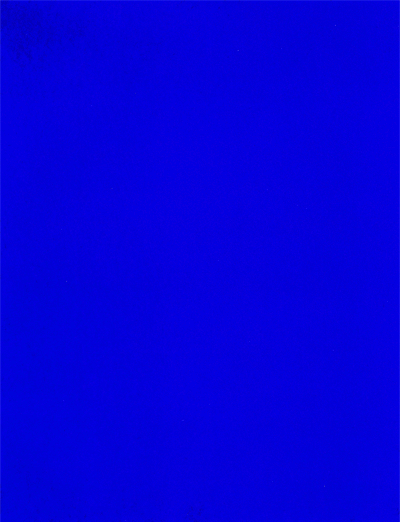
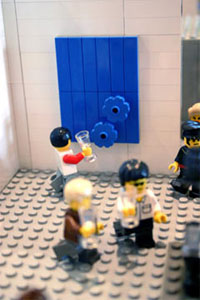
Src: Wikipedia (February 2010)
The International Klein Blue (IKB) is a deep blue hue first mixed by the French artist Yves Klein.
International Klein Blue (or IKB as it is known in art circles) was developed by French artist Yves Klein as part of his search for colors which best represented the concepts he wished to convey as an artist. Although Klein had worked with blue extensively in his earlier career, it was not until 1958 that he used it as the central component of a piece (the color effectively becoming the art). Klein embarked on a series of monochromatic works using IKB as the central theme. These included performance art where Klein painted models' naked bodies and had them walk, roll and sprawl upon blank canvases as well as more conventional single-color canvases.
IKB's visual impact comes from its heavy reliance on Ultramarine, as well as Klein's often thick and textured application of paint to canvas.
IKB was developed by Klein and chemists to have the same color brightness and intensity as dry pigments, which it achieves by suspending dry pigment in a clear synthetic resin. This new medium was patented by Klein.
International Klein Blue is outside the gamut of computer displays, and can therefore not be accurately portrayed on webpages. However this photo of synthetic ultramarine pigment gives a fair impression of IKB as it appears in Klein's work.
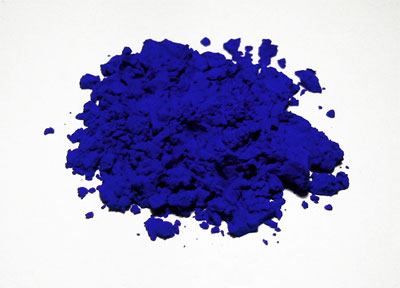
By Greegrue Steepaploe, July 26, 2002, From The SkiFree FanFiction Archive
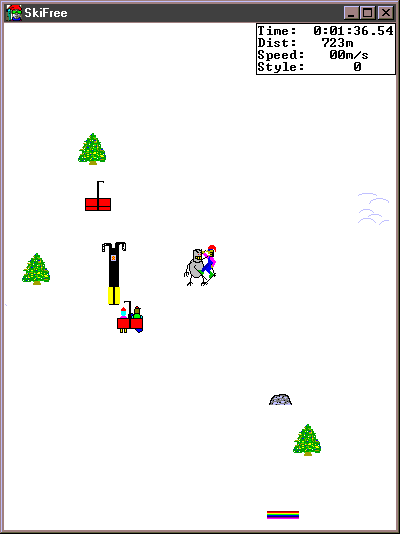
Microsoft SkiFree 1.0
I was cruising through the categories and happened upon this one. I just had to write a story, based on my memories with the game.
He sniffed the crisp, cold air of the mountains and looked at the majestic panoramic before him. Today, he was gonna ski. Oh yeah. Ski a free man. He just hoped that the Abominable Snowman wasn't lurking about. And with a cool air of confidence, he took off down the slopes.
"Hey watch it, asshole!" some amateur woman yelled after him. He couldn't help he showed everyone up. He hit a ramp and did a couple of body contortions, boosting his overall style. When he landed, he accidently bumped a stray dog that happened to be walking by, but all he did was sit down and bark. Or so he thought.
"Heads up, dude!" some punk snowboarder called out to him, as he skied under the skilift. The punk did a daredevil trick and nearly landed on him. 'Oh, that bastard,' he thought. He kept on sking, trying to make good time, for no reason that he could see other than to prove to everyone on the slope that he kicked ass.
He passed the checkpoint and was satisfied with his score. So satisfied, in fact, that he didn't notice he was too deep down the slope, to the point where there were no more dogs, slow skiers, or punkass snowboarders.
"is that!" he shouted as he saw movement in the brush to his right. The Abominable Snowman crashed through the brush, making a loud bellow. The Master of the Slopes skied as fast as he could while doing flips off the ground, but to no avail. The Abominable Snowman leaped onto out hero, and devoured him. He then danced a merry jig for what seemed like eternity.
Fin.
Download and play SkiFree (Windows)
From suck.com, June 8, 2001
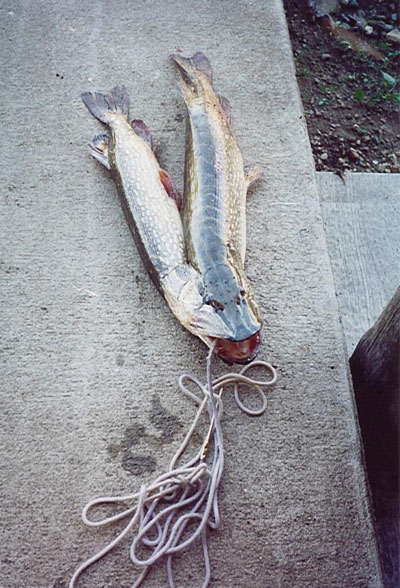
Siamese pike caught in North Bay?
Suck brings back the spirit of history's great vacationers.
Who said Suck is entitled to a vacation?
Well, it all goes back to our abiding ambition to become the Johnny Carsons of the Web. You'll recall that the original latenight smoothie was famous not only for his unflappable desk manner, uproarious animal guests and outrageous "Carnac" routines, but for disappearing for weeks and months at a time, leaving the show in the capable hands of various Brenners and Shandlings. And who can forget the immortal Joan Rivers? Didn't these frequent absences really just make you fonder of old Johnny?
No, they didn't.
But consider how the vacations gave you a chance to reflect on all that Johnny meant to you.
That was back in the eighties, you over-the-hill fuckfaces. We're in a competitive global economy now, where Dave and Jay can't afford to lose even a week's worth of edge.
That's true at the general level, not at the specific. Our surveys indicate Web content in the year 2001 is the least competitive industry since Special Education. What else are you going to read? GettingIt? RequestLine? The Finger?
Better their back issues than your moldy old flapdoodle. Old Sucks are torture — like reading five-year-old Village Voice articles, just like James Wolcott said.
If you really feel this way, maybe you should look into our five years ago today feature.
I've tried that. It just doesn't fulfill me like a brand new Suck, ripped from today's headlines.
If you're looking to Suck for fulfillment, you've got bigger problems than our vacation.
But I do look to Suck for fulfillment. Suck is my [breakfast time/work-shirking/coffee break/lunchtime] reading; without it my life isn't complete.
Then why are you always sending us nasty letters?
It's tough love! I feel that you guys owe me — me personally — your best work, 365 days a year. You can't just leave me hanging like this!
But think how good it will feel when you see the Sucksters again, tanned, rested and ready, with recharged batteries and can-do attitudes!
Who wants a can-do attitude from the Sucksters? You're supposed to be miserable for my entertainment. Whatever happened to suffering for your art?
Every day for six years we've been shucking and jiving for the amusement of a bunch of retards and you say we're not suffering enough?
How dare you refer to me that way? I've been reading Suck since 1995, before you sold out and it really started to blow. You bastards owe me for all that time!
No, you owe us. Why should we have to slave like this without a break?
Because without Suck, who will challenge America's foulest blowhards? Without Suck you've got a whole country of people who think loathsome drizzlerods like Maureen Dowd are incredibly daring and insightful and self-infatuated lardasses like Thomas L. Friedman are shrewd commentators on the world scene. Without Suck who's going to challenge the sad little weasels with nothing going for them? Without Suck it's just grinning idiots all the way down, Steve Martin humor columns, asswipe behind-the-scenes specials about the making of Tomb Raider.
We feel your pain. We truly do. But even schoolchildren get the summer off. We want to be alone.
Fuck what you want. What about my needs? What am I supposed to do in the meantime?
Keep your feet on the ground, keep reaching for the stars, enjoy our hand-selected Suck classics, and keep on dreaming of a better day.
Where is the love?
It's all around you. Can't you feel it?
I guess I can. Is this vacation for real?
Real as the World Wide Web. See you soon.
By Peter Schjeldahl, 7 Days Magazine, June, 1 1988
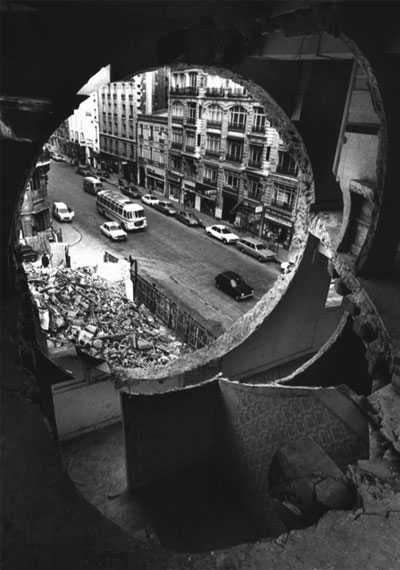
Conical Intersect, Gordon Matta-Clark, 1975
Gordon Matta-Clark, last of the utopians, died of cancer in 1978 at the age of 35, five years after Robert Smithson, the next to last, was killed in a plane crash at the same age. The mid-'70s made a wipe of the anarchic and messianic avant-gardism that had taken hold in American art at the end of the '60s. It would have ended even if Smithson and Matta-Clark had lived: their deaths just added an air of practically metaphysical disaster, as if the gods were angry.
Still, I was moved and stimulated beyond what I had expected when seeing Matta-Clark's retrospective. I felt the ache of an utter exuberance cut short, with so much left undone.
And I felt an inkling that much might be done even now -- or especially now, in our money-sickened art culture -- with hints from Matta-Clark and his "wonderful, socially redeeming harebrained schemes," in the words of Robert Pincus-Witten's catalog introduction.
I knew Matta-Clark in the frontier-era Soho of the very early '7Os, when he was the most energetic of many "informalists" -- guerilla auxiliaries of minimalism and conceptualism -- who whipped up short-lived installations of urban detritus in alternative spaces also used for dance performances, poetry readings, and parties. Political rage was high and rents were low, making antibourgeois values both irresistible and affordable.
It wasn't all that much fun for someone given to critical thinking about art, or about anything. Though brainy in a flashes-of-genius kind of way, the mindset was hippie-ishly anti-rational -- not that ratiocination was even possible given the prevalence of the substances with which we were disqualifying ourselves for Supreme Court judgeships.
Mat5ta-Clark was one of the twin sons of Roberto Matta, the Chilean surrealist, womanizer, and, not to put too fine a point on it, jerk. (The twin committed suicide in 1976.) Bohemian-horn and -bred in New York, Matta-Clark led a semicommunal life centered on nonstop cooking. (He was co-founder of the restaurant Food.) I regret having thrown away, as disgusting, my copy of his famous 1969 Christmas card: a photo of a Christmas tree, fried in grease.
Much of Matta-Clark's work, as documented by him in the bland photos-and-text format of the day, is of the you-had-to-be-there variety: obscure messes of one kind or another. Where he got onto something was in his cutting up of buildings.
Doyen of a group of architecture-trained radicals called Anarchitecture, Matta-Clark went in for acts of literal deconstruction that combined poetic inspiration and daredevil physicality. (His choirboy face topped a Superman body and his lust for danger made dying in bed the least probable of ends for him.) Sometimes illegally, he took chain saws to abandoned structures, with results shocking, dizzying, and delicate.
Matta-Clark's most telling work, and one of the indelible images of our time, is his 1974 Splitting: the clean bisecting of a condemned two-story house in Englewood, N. J. He subsequently cut out the house's top corners, which are on display in Brooklyn along with other engrossing architectural fragments that look mightily prophetic of recent trends in sculpture that exploit materials with a history of social use.
That the Englewood house was a graceless and forlorn old clapboard thing only amplifies its "houseness" as nothing more or less than somewhere people live. Matta-Clark's elegant violence to this most basic human symbol makes for a drastic elegy, mingling sorrow and anger.
Anyone happily lacking personal feelings of dislocation and of some variant of "homelessness" might gaze on the photos and relics of Splitting with equanimity. I can't.
None of Matta-Clark's filleted buildings exist any longer, but his virtuosic photo collages of their interiors --in his later work, baroque shapes cut through floors and walls, communicating vertiginously from sky to basement and from backyard to front yard -- readily convey a perceptual experience keyed to wherever, very carefully watching one's step, one would happen to be in them.
Matta-Clark's chain-sawed environments make meaning by intensifying physical self-consciousncss to ecstatic or terrifying effect.
They are symbols of a life in art conducted outside the upholstered prisons of commerce and institutions, an uncontained existence requiring moment-to-moment location checks: Where am I? Furthermore: What am I, and what am I doing?
I'm not eager for a return to the obligatory anarchy of the early '70s, when people were horrible to each other out of sheer distraction. But everybody knows that the present, market-tyrannized situation of art is intolerable. There has simply got to be another way.
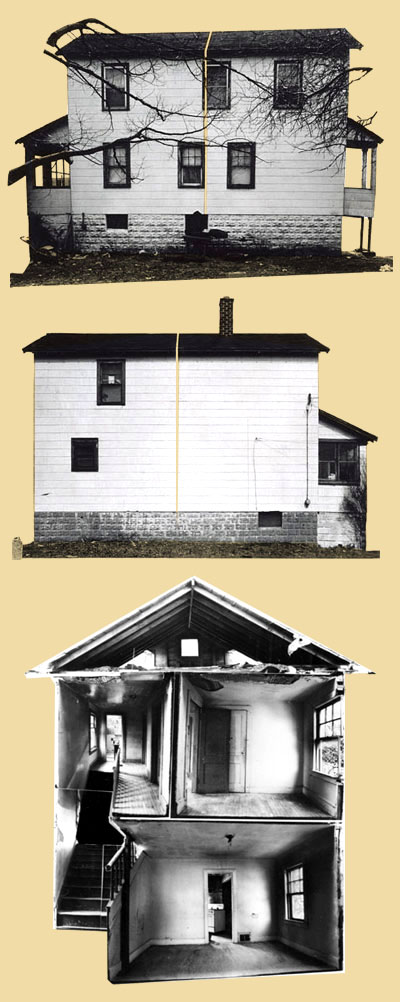
Splitting, Gordon Matta-Clark, 1974
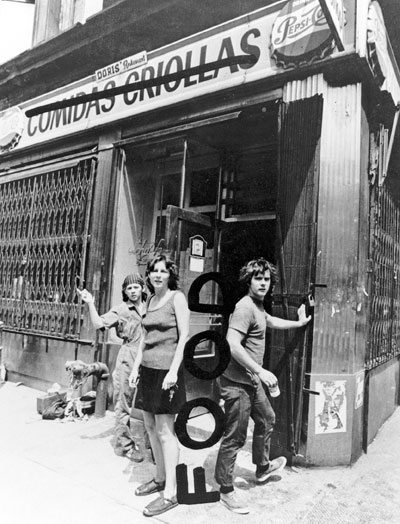
Tina Girouard, Carol Goodden, and Gordon Matta-Clark in front of Food restaurant, Prince Street at Wooster Street, New York, 1971. Photo by Richard Landry, alteration by Gordon Matta-Clark
From RISD
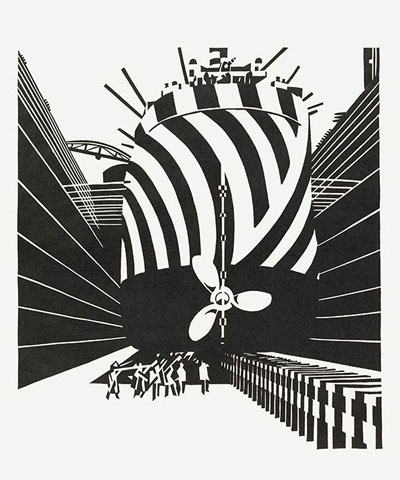
Rhythms of Modern Life by Edward Wadsworth, 1918
The father of camouflage, Abbott Thayer described animal coloration as a way to conceal or disrupt an object. Dazzle is disruptive (think of a zebra). French artists developed military camouflage in World War I. Ships were hard to camouflage against U-boats because the sea and sky were always changing and of the smoke they produced. Norman Wilkinson, a marine painter who was in the Royal Navy, is credited with being the first to develop dazzle camouflage for ships. The Royal Navy allowed him to test his idea. When the test went well Wilkinson was told to proceed, however, he was given no office space. So he went to his alma mater the Royal Academy and was given a classroom. Wilkinson hired Vorticist Edward Wadsworth to be a port officer in Liverpool, England and oversee the painting of dazzle ships. In 1918, Wilkinson came to United States to share his dazzle plans. 1,000 plans were developed through this partnership.
Did it work? Dazzle and the convoy system were implemented about the same time, so it is hard to say. However, crews on dazzle ships were very proud of the bedazzled camouflage. It was definitely a morale booster. The British and the Americans fully adopted dazzle because at the time they found it to be effective and inexpensive.
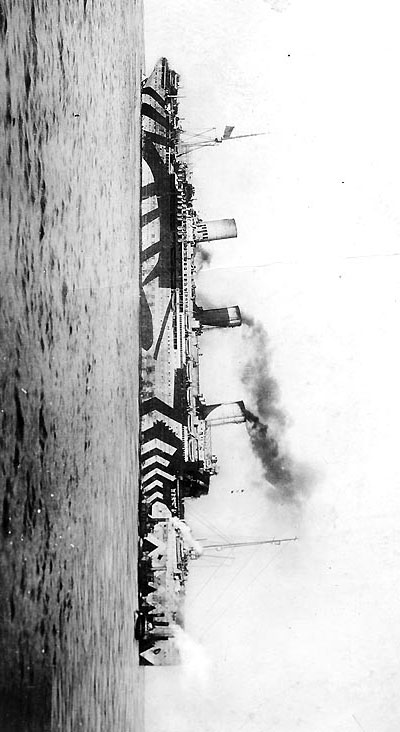
USS Leviathan, 1918 (Rotated 90 degrees right)
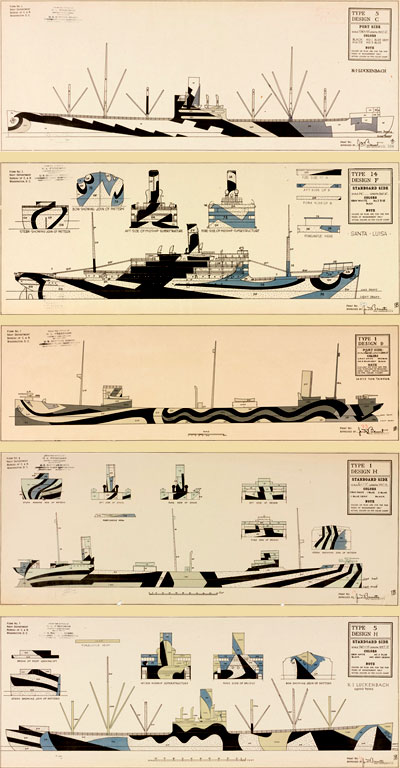
Images courtesy of the Fleet Library at RISD
In 2008, the Fleet Library at the Rhode Island School of Design announced the rediscovery in its collection of 455 lithographic printed plans for the camouflage of US merchant ships during World War I. These documents were donated to the RISD library in 1919 by one of the school's alumni, designer Maurice L. Freeman, who had been a camouflage artist for the U.S. Shipping Board in Jacksonville, Florida. Portions of the collection were publicly shown at the RISD library for the first time from January 26 through March 29, 2009, in an exhibition titled "Bedazzled."
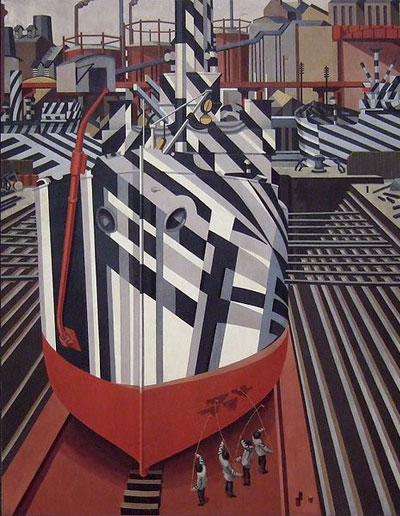
Dazzle-ships in Drydock at Liverpool by Edward Wadsworth, 1919
By Jeannie Schulz, from the Charles M. Schulz Museum, 2004
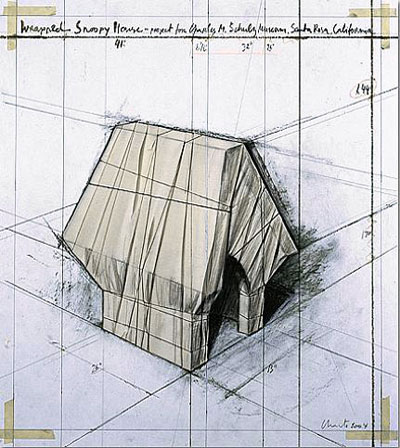
Christo Wrapped Snoopy House - Project for the Charles M. Schulz Museum, Christo, Hand-Collaged Lithograph, 2004
Charles Schulz was not so much an instant advocate of the Running Fence project in Sonoma County as he was puzzled by the heated "chicken little" rhetoric opposing the idea. It was 1975, I believe, when we listened to an overflow crowd argue before the Sonoma County Board of Supervisors. As always, Christo and Jeanne-Claude were calm and seemed almost oblivious to the furor created by their proposal. Weeks later, we were fortunate to meet Christo and Jeanne-Claude in a smaller setting where they discussed this project and showed a video of their Valley Curtain project in Rifle Gap, Colorado.
In September 1976, Schulz (Sparky) flew over the length of Running Fence with his son, Craig, and viewed an unforgettable image of our golden Sonoma County hills and the coastline as the fence dipped into the Pacific.
As art follows life, Christo's project became the subject of a Peanuts comic strip on November 20, 1978. The circle was completed in October 2003, when Christo and Jeanne Claude unveiled a 3-D version of the last panel of the 1978 comic strip.

Peanuts, November 20, 1978
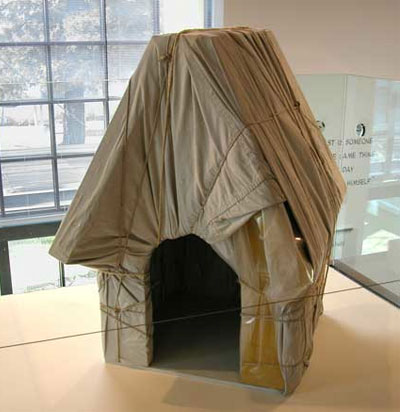
Christo Wrapped Snoopy House - Project for the Charles M. Schulz Museum, Christo, 2003
From Subterranean Cinema
This is the final scene from Norman Mailer's MAIDSTONE, in which he played the part of a famous movie director running for President of the United States, who is supposed to be assassinated in the finale.
Mailer concluded principal photography without resolving the final scene, and Rip Torn (playing his brother-in-law and assassin) allegedly decided to take it upon himself to "improvise" an attack by hitting Mailer on the head with a small hammer, drawing blood. Mailer retaliated by tackling and then nearly chewing Torn's ear off as they grappled viciously, and it rapidly escalated into an unhinged on-camera brawl as Mailer's horrified kids screamed in terror.
This is the completely uncut sequence. I have to wonder how "unplanned" it was, as the camera is obviously following Rip closely in the moments before the attack, and if principal photography had finished the day before, why was the camera crew still hanging around filming Rip and the Mailer family? Its more like Mailer knew Rip would pull something for the camera, but didnt know what, and overreacted because he wasnt expecting him to use a real hammer and actually start hitting him with it.
Mailer's verbal reaction is oddly artificial (although the ear chewing is very real and painful to watch) and his wife seems to be lurking just off camera, and then she suddenly starts screaming like a banshee, which is what sets the kids off. Rip seems to be truly apologetic and convincing in the moments after the fight, but Mailer is barely audible and withdrawn and struggling to improvise lame insults to throw back at Torn, who starts becoming irritated at the end by Mailer's weak and phony outrage. It's rather ironic considering his fame as a great writer that he cant come up with snappier dialogue, or deliver it convincingly.
Whatever the circumstances of the event, it's a truly strange and classic sequence indeed, and Rip's demented final facial expressions are unforgettable. I think that when Mailer says "you might as well turn that tape off, because he's a very dull talker, and he never stops as long as anything is running", Rip's hilarious "ooo, OOOO!!" stare and point response was probably his way of saying that Mailer was being hypocritical.
For more information on Mailer's ultrarare 60s trilogy of experimental films (Wild 90, Beyond the Law, Maidstone), visit Subterranean Cinema.
